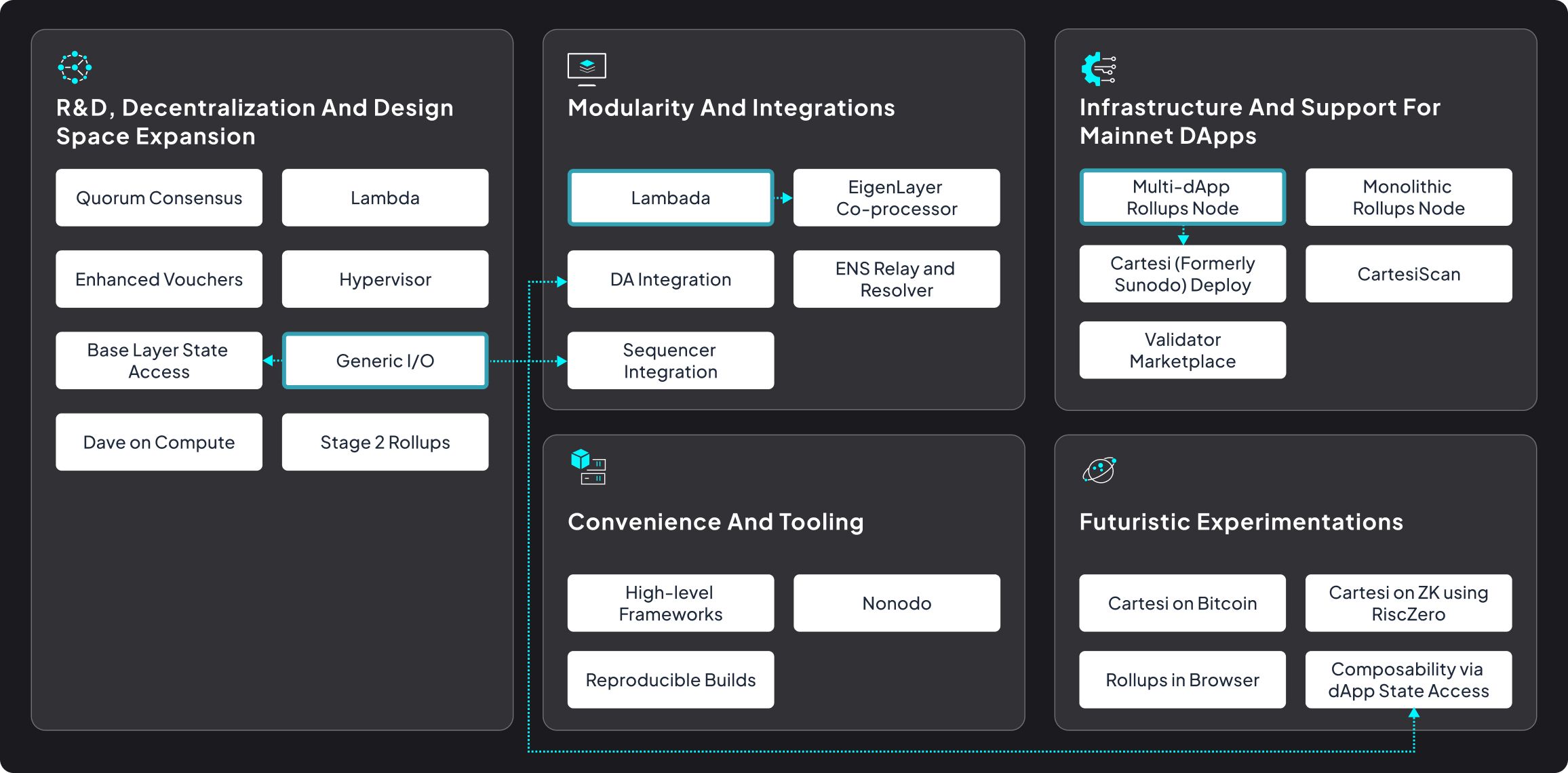
Technical Evolution Plan
This collaborative initiative is shaping the further development and progression of Cartesi's protocol technology through a technical evolution plan. It stands as a dynamic, evolving technical roadmap, maintained by the Technical Vision Council and created through a decentralized process driven by Cartesi contributors, ecosystem grantees, and the broader community.
At a Glance
Learn more about the ecosystem’s process for creating the Technical Evolution Plan, a new approach in decentralized coordination and governance for the Cartesi community here.

R&D, Decentralization and Design Space Expansion
Continuous technical research, stack design, and development of new technologies committed to positioning Cartesi at the forefront of Web3 innovation and decentralization.
Quorum Consensus
Interim consensus model surpassing single Authority validation and preceding Dave, employing a fixed set of validators to vote on dApp history additions.
Generic I/O
Key functionalities for modular integrations allowing Cartesi dApps to access external data via hash, for multi-source retrieval, surpassing systems requiring explicit input sending.
Lambda
Upgraded designed approach for enhancing reliability, upgradability, and scalability by isolating dApp states for single-input processing and easy external state inspections.
Base layer state access
Extended capabilities for the integration of Cartesi dApps with base layer data for enhanced analytics, responsiveness, and seamless interaction with sequencers.
Enhanced Vouchers
Implementation of dApps’ output in the form of complex vouchers (including time-based vouchers) as a library, enabling flexibility and added functionalities.
Dave on Compute
Enhancements to improve Cartesi Machine's efficiency in generating state hashes for more frequent updates, marking a new stage in its approach to dispute resolution.
Hypervisor
Mechanism enabling compartmentalization and concurrent execution of programs on Cartesi Machine, facilitating code isolation and mitigating trust in untrusted components.
Stage 2 Rollups
Permissionless fraud-proof system, Sybil-resistant, where a single honest validator can enforce the correct result, without being susceptible to delay attacks.
Modularity and Integrations
Active developments within the modular blockchain architecture: Integrations of Cartesi's execution layer with DA layers, sequencers, blockchain naming systems, and more.
Lambada
Alternative pathway for streamlined development of an app-specific rollup (appchain) within the Cartesi ecosystem.
DA Integration
Integration with alternative Data Availability layers of Celestia, Espresso, Near or Syscoin for enhanced data abundance, cost efficiency, and broader ecosystem interoperability.
ENS Relay and Resolver
Integration of an ENS resolver and relay in Cartesi's execution layer for users to gain the ability to interact with dApps under their ENS identity.
EigenLayer Co-Processor
Accessible and reliable computational frameworks, akin to a co-processor supplementing existing EVM or other processes, integrated within existing blockchain infrastructure.
Sequencer Integration
Sequencer integration for soft finalization and cost-effective input inclusion, enhancing user experience and marking a logical progression in Cartesi's rollup stack's evolution.
Infrastructure and Support for Mainnet Applications
Ongoing focus on a suite of tools necessary to provide infrastructure, maintenance, and support components for decentralized applications deploying on L1 or L2 mainnets.
Multi-dApp Rollups Node
Cartesi Rollups Node feature enabling a single Node to manage multiple dApps with runtime add/remove functionality.
CartesiScan
Rollups Explorer mirroring Etherscan's functionalities for Cartesi's architecture, ensuring transparency, accessibility and manageability for Cartesi dApps.
Validator Marketplace
Streamlined node infrastructure management in a competitive environment, connecting dApp developers with validators, and using CTSI tokens for staking and delegation to align incentives for ecosystem growth.
Cartesi Deploy
Service layer, an integral component of Cartesi’s tech stack, enabling developers to launch and operate their dApps with just a few clicks through a Command Line Interface.
Monolithic Rollups Node
Simplified new architecture for Cartesi Rollups Node as a monolithic application, enabling convenient implementation of upgrades and new features.
Convenience and Tooling
Implementation of a set of features aiming to enhance the developer experience through convenience tooling that eases Cartesi dApp creation and deployment.
High-level Frameworks
Application development frameworks meant to simplify developer onboarding experience by integrating a range of widely used programming languages and architectures.
Reproducible Builds
Mechanism for reproducible builds, critical for security-sensitive software, allowing verification that executed code matches the original source code and dependencies.
NoNodo
Optimized non-node, alternative to Cartesi Node, emulating the conditions of a full node's production environment running locally for streamlined dApp deployment cycles.
Futuristic Experimentations
Pilot developments aimed at challenging and expanding Cartesi's technical boundaries at the convergence of various other technologies, in a quest for trailblazing innovations.
Cartesi on Bitcoin
Prospects of positioning the Cartesi Machine as Bitcoin's primary innovation entry point, acting as the go-to execution environment for protocol stacks lacking a powerful VM.
Rollups in Browser
Direct Cartesi Machine execution in browsers for efficient and user-friendly dApp interactions with reduced resources use, simplifying web applications integration.
Cartesi on ZK using RiscZero
Explorations around validating Cartesi Machine execution via Zero Knowledge Proofs, providing dApps with a level of privacy that surpasses what Optimistic Rollups can offer.
© 2025 The Cartesi Foundation. All rights reserved.







